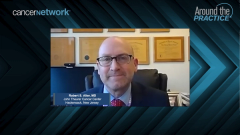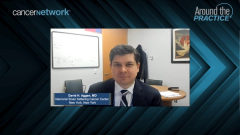
Patient Profile 2: Intermediate-Risk RCC Treated With Ipilimumab + Nivolumab
Expert perspectives on the clinical scenario of a patient with intermediate-risk renal cell carcinoma, who is managed with the immunotherapy combination of ipilimumab and nivolumab.
Episodes in this series

Transcript:
Robert J. Motzer, MD: Let's move on to clinical case 2, which Dr Aggen will be presenting.
David H. Aggen, MD: This was a 52-year-old male who presented in January of 2021 with flank pain and hematuria. He had a past medical history notable for hypertension on an ACE inhibitor, type 2 diabetes on metformin, obesity, and asthma, and he has no known family history of malignancy. A CT scan following an ER visit for hematuria showed unfortunately a 9.5 cm x 8.6 cm x 7 cm right renal mass with some extension in the IVC [inferior vena cava]. In January of 2021, the patient underwent a radical nephrectomy, and pathology was consistent with clear cell RCC [renal cell carcinoma]. At that point in time, there was no standard adjuvant immunotherapy approach that was FDA approved, and he was continued on surveillance at that point in time. Surveillance imaging about 7 months post-nephrectomy showed pretty diffuse new mediastinal and hilar lymphadenopathy that measured up to 5 cm. There was no evidence of liver or osseous metastases and no evidence of pulmonary metastasis but pretty large adenopathy that wasn't apparent even in April of 2021. The patient had an EBUS [endobronchial ultrasound], and a pathology from a higher lymph node showed a PAX8 positive, CK7 positive, CA9 positive carcinoma consistent with clear cell RCC. Based on time from diagnosis to treatment of less than 1 year, and the rapid growth of this lymphadenopathy, I felt this patient was intermediate-risk and he warranted a treatment. We had a discussion of IO [immunotherapy]/TKI [tyrosine kinase inhibitor] versus IO/IO, and based on the long-term data from the Ipi-Nivo study showing a 4.5 year meeting in overall survival with ipilimumab and nivolumab, we elected to proceed with nivolumab and ipilimumab. He started on nivolumab and ipilimumab and he received 3 doses, and about 10 weeks into the therapy, the patient developed blurry vision, eye pain, and some eye strain. He was seen by ophthalmology and he, unfortunately, was diagnosed with posterior uveitis. He was started on systemic steroids as well as steroid eye drops and fortunately had a reversal of the uveitis. Restaging imaging that was done while he was still on that steroid taper showed a partial response with a 50% reduction in lymphadenopathy. The subcarinal lymph node was half the size and a lower right peritracheal lymph node was 1.1 cm x 1.5 cm. He was subsequently tapered off prednisone over the course of about 2 months with close consultation with our ophthalmology group. He remains on surveillance off of systemic treatment now for more than 6 months, with his most recent imaging actually showing a continued response. I think this case illustrates the double sword of combination PD-1 and CTLA4 blockade, that we often see responses with potentially time-off treatment but with some other toxicities, perhaps.
Robert J. Motzer, MD: This is really an informative case of a patient with intermediate-risk clear cell RCC who is treated with the IO/IO combination with ipilimumab and nivolumab and has a response, but in a setting of immune-related toxicity, required a discontinuing of treatment. Mehmet [Mehmet A. Bilen, MD], in terms of ipilimumab and nivolumab, what has been the data in first-line for this particular program for RCC?
Mehmet A. Bilen, MD: Thank you so much, Dr Motzer [Robert J. Motzner, MD]. I'm happy to go over the recent data. As we know, of all those frontline options, ipilimumab and nivolumab has the longest follow-up data. Actually, you presented ESMO [European Society for Medical Oncology] 2021 the 5 year follow-up data, which is overall remarkable. As we know from the CheckMate 214 trial, patients with clear cell RCC with no prior treatment were randomized to nivolumab plus ipilimumab followed by nivolumab maintenance versus sunitinib, and the primary endpoints included OS [overall survival], PFS [progression-free survival], and objective response rate in IMDC [International Metastatic RCC Database Consortium] intermediate and poorest population. An initial paper published in New England Journal of Medicine in 2018 led to the approval of this combination, and the last several years we starting using it for our patients with newly diagnosed RCC. At ESMO 2021, we learned the 5 year follow-up data. The median OS was 56 months in nivolumab plus ipilimumab arm versus 38 months in sunitinib arm in intention to treat [ITT] population [analysis] and 47-month versus 27 months in IMDC intermediate and poorest group. In addition to that, in the nivolumab plus ipilimumab arm, the probability of remaining alive 2 years beyond the 3 year landmark was 81% in ITT versus 79% in intermediate and poor-risk versus 85% in favorable group. In addition to OS, PFS also remained durable. I think overall, the data look very promising, very appealing, and the long-term follow-up in this 5 year analysis demonstrated durable efficacy for nivolumab and ipilimumab in this patient population.
Robert J. Motzer, MD: Oh, thanks very much. Now, so David [David H. Aggen, MD] and your choice, what were the factors that made you choose nivolumab and ipilimumab for this particular patient, and are there other patients of intermediate or poor-risk that you would preferentially go with a TKI/IO, and what kind of factors go into that decision for you?
David H. Aggen, MD: I think for this patient, he's relatively young, and if I where to put him on an IO/TKI combination, I'm likely committing that patient to be on a pill for months or years. I think in the pembrolizumab and lenvatinib study, the median time on treatment was about 17 months. So to commit somebody who's 52 to a TKI has some other practical risks and other chronic toxicities. For this particular patient, having a treatment-free interval was important to him. He had young children and the promise of being in that 40% of patients that are in that tail on the curve in CheckMate 214 was worth the risk of additional autoimmune toxicities. I usually will steer away from IO/IO therapy to an IO/TKI if I think the patient's really symptomatic with bulky disease and I need a response quick. In his case, he wasn't at all symptomatic from the higher lymphadenopathy, and in that case, I thought he was really an ideal candidate actually for a combination of nivolumab and ipilimumab.
Robert J. Motzer, MD: That's great. What about patients with autoimmune disorders or a history of rheumatoid arthritis or so forth? Are they patients you steer toward one or the other or avoid completely?
David H. Aggen, MD: I think it depends on the toxicity, and there are certain toxicities like arthritis that's managed with topicals that you can risk-challenge with a PD-1 therapy. Certainly, we're worried about an increased risk of autoimmune toxicities when we add in CTLA4 blockade. In CheckMate 214, I think 40% of patients required steroids at some point, so for patients who have underlying autoimmune toxicities, that would definitely make me steer more towards a PD-1/TKI combination in close consultation with other specialists who are managing those autoimmune conditions. It has come up in our center, for patients with organ transplants, my general feeling is you should steer away from any PD-1 or PD1/CTLA4 therapy in those patients.
Transcript edited for clarity.
Newsletter
Stay up to date on recent advances in the multidisciplinary approach to cancer.
























































































